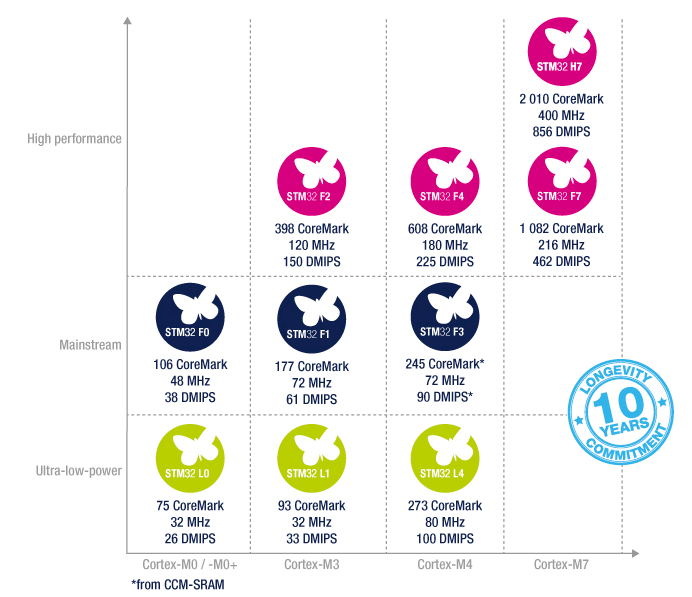Follow
us on
Twitter to stay informed on new publications
NEWS
- The
SILICA ST Days are here.
- It
happened that STM has updated their
website, during this update STM changed the name of a few pages
and the result was the loss of many links.
Click here to see how to
find the the new links.
In my web pages I proceeded to fix the links, if
any are missing, let me know.
- How to install drivers on Windows 8/8.1 and 10
Things
to remember
- What should I use
to develop on STM32 ?
- STM32
HW & SW tools
- STM32 third party for : IDE, RTOS, TCP/IP, USB,
FILE SYSTEM, CAN, etc.
- Small introduction to the ARM
Cortex
family
- Why
use CORTEX Mx family instead of 8 and 16 bit MCU
- What is Wireless
M-BUS and STM solutions
- Wireless M-BUS (WMBUS)
- ST WMBUS Stack features
- STM32L & SPIRIT1 WMBUS
- SPIRIT1 WMBUS packet structure
- STM32L WMBUS Firmware library
- WMBUS PC GUI
-Smart GAS Meter
- C & C++ language
- SILICA
MCU and STM Solution Summit 2012
- STM Motion Control STM
- Embedded Connectivity
- Tutorial on Electrical Motors
- DFU or DfuSe is software that is used for upgrade the
firmware on the boards based on STM32 via USB.
- STM Virtual COM Port Driver
this driver is necessary for use the STM32 USB Full Speed device
library.
- Oscillator design
guide for STM microcontrollers
- Introduction to Networking and Ethernet (TCP,
IP, UDP, etc) in English
- Introduzione al Networking e a Ethernet (TCP,
IP, UDP, ecc) in Italiano
- STM32 & TFT
color LCD
Up to now it is possible interface via FSMC the TFT color
LCD with controller on board...
- Manuale
in Italiano: Sviluppare su STM32F0
- Manual
in English:
Developing on STM32F0
- STM
Analog Website Support - SMPS @ eDesign Studio
This tool simplifies
power supply design and offers designers the flexibility to choose the
right products and topologies.
- How to use LCD 2xN characters
- Standard connectors
- Acronyms
- SPI
- CRC
- RS485
- ASCII table
- AD converter
- Big-endian e Little-endian
- Linux basic
commands
Old
SW/FW
Cookies for European Law
SpeedTest
|
|
Microcontroller
& C
STMicroelectronics
video on YouTube
Presentations, Tutorials, Exhibitions
and more...
STM news
In this section you will find the
latest news from STM.
Marketing presentations from STM and SILICA
are here
STM Studio
STM
Studio helps debug and diagnose STM8 and STM32 applications while they
are running by reading and displaying their variables in real-time.
STM32 Cube 
STM32 pin allocation, code generator and more that
substitute the MicroXplorer.
STM brochure &
flayer  STM8
STM8
ST's
8-bit microcontroller platform is implemented around a high-performance
8-bit core and a state-of-the-art set of peripherals.
Performance: @24MHz - 6
DMIPS - 5 CoreMark
The
STM8 platform supports three main product lines:
STM8S,
general-purpose MCU
STM8L, ultra-low-power EnergyLite™
MCU
STM8A, automotive MCU
STM8AL, automotive
ultra-low-power MCU
EvaBoard for STM8 DALI is here
STM32-STM8 embedded software solutions
(update to January 2012, pdf 1.9MB),
is here.
STM32
The
STM32 family of 32-bit Flash microcontrollers is based on the
breakthrough ARM Cortex™ M0, M3, M4 and M7 core featuring architectural
enhancements with the Thumb-2 instruction set to deliver improved
performance with better code density, significantly faster response to
interrupts, all combined with industry-leading power savings. It offers
a complete 32-bit product range while maintaining full integration and
ease of development.
In addition, STM every day works to improve the STM32 EcoSystem.
The
STM32 main product lines:
STM32H7xx, top very high performance MCU + TFT
controller - Cortex
M7
STM32F7xx, very high performance MCU + TFT
controller - Cortex
M7
STM32F4xx,
general-purpose MCU + TFT controller
- Cortex M4
STM32F3xx, for analog
applications MCU - Cortex M4
STM32F1xx
& STM32F2xx,
general-purpose MCU - Cortex M3
STM32F0xx, general-purpose MCU - Cortex M0
STM32L4xx, ultra-low-power EnergyLite™ MCU - Cortex M4
STM32L1xx,
ultra-low-power
EnergyLite™ MCU - Cortex M3
STM32L0xx, ultra-low-power
EnergyLite™ MCU - Cortex M0+

- Page related
to: STM32L0xx - Cortex M0+ ultra-low-power
Performance:
@32MHz - 26 DMIPS - 75 CoreMark/MHz
- Page related
to: STM32L1xx
- Cortex M3 ultra-low-power
Performance:
@32Mhz - 33 DMIPS - 93 CoreMark
- Page related
to: STM32L4xx - Cortex M4 ultra-low-power
Performace:
@80Mhz - 100
DMIPS - 273 CoreMark
- Page related
to: STM32F0xx - Cortex M0
Performance:
@48MHz -
38 DMIPS - 106 CoreMark
- Page related
to: STM32F1xx
- Cortex M3
Performance:
@72
Mhz - 61(90) DMIPS - 177
CoreMark
@24 Mhz - 30 DMIPS -
51 CoreMark
- Page related
to: STM32F2xx
- Cortex M3 high performance
Performance:
@120 MHz - 150 DMIPS - 398 CoreMark
- Page related
to: STM32F3xx
- Cortex M4 for analog
applications
Performance:
@72 MHz - 90 DMIPS - 245 CoreMark from CMM-SRAM
- Page related
to: STM32F4xx -
Cortex M4, include TFT controller
Performance:
@168/180 MHz - 225 DMIPS@180MHz - 363
to 608 CoreMark (compiler dependent)
- Page related
to: STM32F7xx - Cortex M7, very high performance MCU, + TFT
controller
Performance:
@200 MHz - 856 DMIPS - 1000 CoreMark
- Page related
to: STM32H7xx - Cortex M7, top very high performance MCU, + TFT
controller
Performance:
@400 MHz - 428 DMIPS - 2010 CoreMark
- Page related
to: STM32Wxx - Cortex M3 with transceiver at 2,4Ghz
Performance:
@24 Mhz - 30 DMIPS - 78 CoreMark
ATTENTION:
STM32Wxx is not to use for the new projects.
For more info contact your local SILICA / STM
office.
-
- Oscillator design
guide for STM8S, STM8A and STM32 microcontrollers, AN2867
- STM32 Class B -
IEC60335
- STM32
snippets
a set of examples to
help the designers when creating their own fully optimized C-code
application.
- NUCLEO eva
boards
STM32 Nucleo – open development hardware supporting Arduino™
connectivity and mbed.
STMicroelectronics is following a new path to support engineers in
evaluation of MCUs and prototyping their applications.
- X-NUCLEO
The
X-NUCLEO board are shields for NUCLEO eva Board.
- ARM mBed
The ARM
mbed IoT Device Platform provides the operating system, cloud services,
tools and developer ecosystem to make the creation and deployment of
commercial, standards-based IoT solutions possible at scale.
- Introduction to USB
- STM32 Open
Development Environment (ODE)
The STM32 Open Development Environment (STM32 ODE) is an open,
flexible, easy and affordable way to develop innovative devices and
applications based on the STM32 32-bit microcontroller family combined
with other state-of-the-art ST components connected via expansion
boards. It enables fast prototyping with leading-edge components that
can quickly be transformed into final designs.
- IDE
tips and tricks
KEIL
IAR
ATOLLIC
- STemWin
Professional graphical stack library
enabling the building up of Graphical User Interfaces (GUIs).
- DALI for STM32
Dali slave example for STM32F and
STM32L families
User Manual DALI
SLAVE INTERFACE
- STM32 HW and SW
tools
DFU, USB Driver, Audio library,
Virtual COM, EvaBoards, etc
- ARM and STMicroelectronics join with Mathworks to Enable Code
Generation, Debug and Modelling For STM32 Microcontrollers
- uCLinux and STM32
- Drones and STM32
- STM adopt Thingsquare’s OS (Mist OS) for ‘Internet of Things’, see here
and here.
- The products
compatible with Mist are ST's SPIRIT1 radio transceiver on the
STM32L
microcontroller platform.
- VGA output using a 36-pin STM32F103
is here
- STM32 and APPLE (iPAD, iPOD, etc) is here
- Page related
to: DiZiC
ZigBee Star Network
- Silica Xynergy
Board - STM32 meets Spartan-6
- Silica porfID Board - STM32F meets STM8L and RFID
- ESPRUINO is easy to use HW based on STM32
- ARDUINO STAR OTTO and STM32
- ARDUINO
developed using the STM32F103
- STM32 goes Java
- .NET micro framework for the STM32
- DMX-512
protocol for ligthing control
- STM32
motor control
- STM32-STM8 embedded software solutions
(update to January 2012, pdf 1.9MB),
is here.
- Small introduction to the ARM Cortex
family is here.
- Production programming tools for
STM32 is here.
- STM32 Journal
STM32 and STM8 MCU
Longevity Commitment
STMicroelectronics
provides a minimum longevity commitment of 10 years for its below
listed STM32 ARM® Cortex®-M and STM8 microcontrollers.
STM32 & STM8 product finder app for smartphone &
tablet is here
STM32 training courses (for Europe) see here
Evaluation
Boards for STM8 & STM32 are here
SPEAr embedded MPUs (ARM9 & CORTEX A9)
SPEAr®
eMPU family are 32-bit ARM® ARM926EJ-S or Cortex-A9 based devices for
cost-sensitive applications requiring significant processing and
connectivity capabilities at lower power consumptions.
SPC5 - 32-bit
family for automotive (Power PC) 
The
SPC56 family of 32-bit automotive microcontrollers is designed using
Power Architecture™ and ST’s 90 nm embedded Flash technology. Developed
within the framework of the STMicroelectronics/Freescale Joint
Development Program (JDP), it combines a scalable range of 200 cores
with innovative peripheral sets that are optimized for building
efficient applications in engine management, chassis, safety, body
control and instrument clusters.
STR9 ( WebServer )
Introduction to Networking and
Ethernet (TCP, IP, UDP, etc) in English is here
(pdf)
Introduzione al
Networking e a Ethernet (TCP, IP, UDP, ecc) in Italiano è qui (pdf)
Xpander
Xpander
devices are general-purpose input/output port expanders to interface
digital ASICs via a two-line bidirectional bus (I²C). Intelligent
features offered by Xpander logic include an advanced matrix keypad
controller supporting up to 96 keys and an advanced PWM controller
providing complex brightness pattern control.
Companion Chip for
STM8 & STM32 (H1/13)
The documentation contain references
to:
MEMS
Signal Conditioning
Data Converters
Power Discretes and Modules
Power Management
Connectivity
(WireLess and RFID)
Clock and Timing
Memories
Level Translators
Reset and
Supervisors
ST-LINK
& ST-LINKv2
The ST-LINK is an in-circuit debugger and programmer for the STM8 and STM32 microcontroller families.
The SWIM
and JTAG/SWD interface is used
to communicate with the STM8 or
STM32 microcontroller located on your own application board.
DLL for STVP
STVP is: ST Visual Programmer for
programming ST7, STM8, STM8T and STM32.
If you need to
customize the STVP is possible using DLL package (for Windows), for more info see here.
MCU Companion Chip
Various
Funny BLINK(1)
Vecchie riviste di elettronica
Defend your data & communication on the Internet
- TOR a
way to surf, share data and more, on Internet with a secret identity.TOR browser is here
- Streembit - Decentralized, peer-to-peer, secure communication system for humans and machines.
See also this step by step article.
- Encryption to transmit sensitive or personal data - GnuPG
NINUX
is an alternative model to the development of telecommunications
networks, a model based on sharing, cooperation and freedom, in
accordance with the philosophy of free software.
Serval Mesh
for ANDROID Phone
How
to solder the TQFP, see below.
C Compiler
Python
RaspBerry Pi
Linux
& C
INTERNET,
ADSL & C
ANDROID
iPad
Packard
Bell DOT M/A
General
Pourpose
CRYPTO
FI
LMs
|





































